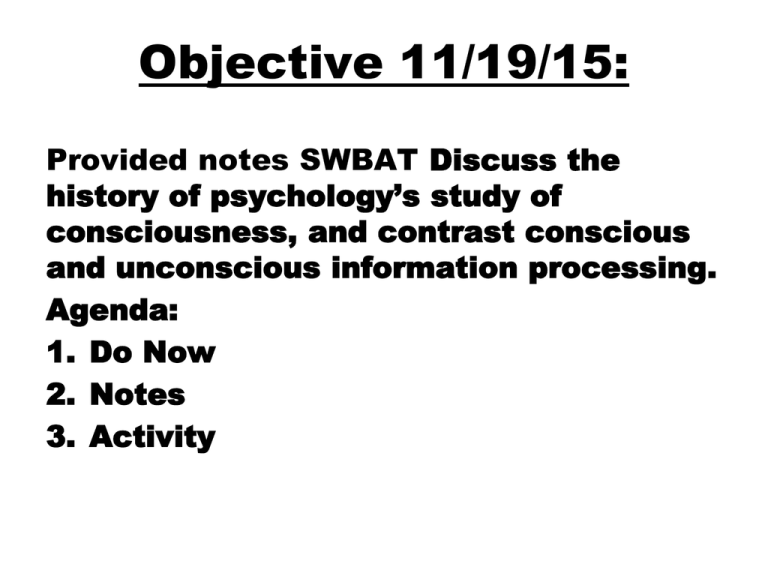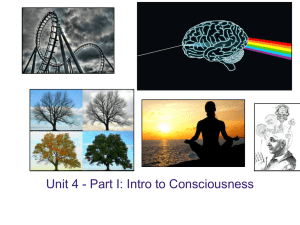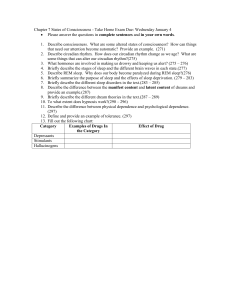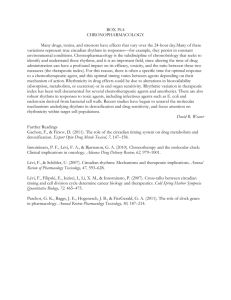Notes 1 States of Consciousness
advertisement

Objective 11/19/15: Provided notes SWBAT Discuss the history of psychology’s study of consciousness, and contrast conscious and unconscious information processing. Agenda: 1. Do Now 2. Notes 3. Activity Unit 4: Intro to Consciousness What is consciousness? You are aware of you... right? Individual awareness of your unique thoughts, memories, feelings, sensations & environment. Conscious experiences are constantly shifting & changing. One moment you may be focused on these notes. Your consciousness may then shift to the memory of a conversation you had earlier with a friend. Next, you might notice how uncomfortable your chair is or maybe you are day-dreaming about dinner. This ever-shifting stream of thoughts can change dramatically from one moment to the next, but your experience of it seems smooth and effortless. Consciousness Consciousness: our level of awareness about ourselves and the environment. This psychological definition implies that consciousness is NOT like an on/off switch. We are NOT conscious or unconscious. Psychologists refer to different levels & states of consciousness. It is ironic that we experience states of consciousness... without being fully aware that we are experiencing them! Not all researchers agree about what specific levels of consciousness there are, but there are some possible suggestions that most agree to... Conscious Level - What you are currently aware of, including yourself & environment. Nonconscious Level - Body processes controlled by your mind that are not usually (or ever) aware of... Heartbeat, respiration, digestion, etc. Preconscious Level - Information about yourself & environment that you are NOT currently thinking about, but could be. You aren’t currently thinking about your favorite toy as a child, but if asked about it, you would be. Subconscious Level - Information we are not currently aware of, but we know must exist due to behavior. (Great example: Mere Exposure Effect - when we prefer stimuli we have seen before over novel/new stimuli, even if we do not consciously remember seeing the old stimuli.) Waking and Sleeping Rhythms When we are awake, we are in a state of consciousness. Consciousness refers to the active processing of information in the brain. It could be thought of as a form of short-term memory & attention combined. It is the activity running through our heads or minds. (stream of consciousness) Brain activity can be measured by using an EEG. Great analogy of conscious behavior: Conscious Subconscious Unconscious D A Y D R E What are some common Day Dreams & Fantasies? F A N T A S I A E M S S Dreams can help us prepare for future events ★ nourish our social development ★ substitute for impulsive behavior Why do we daydream? Biological Rhythms Annual Cycles: seasonal variations (examples: bears hibernation, seasonal affective disorder) ★ 28 day cycles: menstrual cycle ★ 24 hour cycle: our circadian rhythm ★ 90 minute cycle: sleep cycles SEASONAL AFFECTIVE DISORDER (SAD): Diagnostic and Statistical Manual of Mental Disorders DSM-IV & DSM-5: Recurrent major depressive disorder that occurs at a specific time of the year & fully remits otherwise. Must meet 4 criteria: 1. Depressive episodes at a particular time of the year; 2. Remissions or mania/hypomania at a characteristic time of year; 3. Patterns must have lasted 2 years with no nonseasonal major depressive episodes during that same period; 4. Seasonal depressive episodes outnumber other depressive episodes throughout the patient's lifetime. Prevalence in the U.S. ranging from 1.4% in Florida to 9.7% in New Hampshire. Symptoms of SAD: ★ difficulty waking up in the morning ★ morning sickness ★ tendency to oversleep ★ over eating ★ especially a craving for carbohydrates, which leads to weight gain. Other symptoms include a lack of energy, difficulty concentrating on or completing tasks, withdrawal from friends, family, and social activities, and decreased sex drive. Circadian Rhythm Circadian 24 hour biological processes that may be interrupted by exposure to light Resets biological clock by affecting suprachiasmatic nucleus and pineal gland which secretes melatonin. Jet lag & shift work can also knock circadian rhythms out of sync. ★ Our 24 hour biological clock. ★ Our body temperature & awareness changes throughout the day. ★ It is best to take a test or study during your circadian peaks. How can the circadian rhythm help explain jet lag? Circadian Rhythm 3 Types of Rhythms: 1. Circadian - 24 hour daily cycle. 2. Infradian - Longer than 1 day: ★ ★ ★ ★ Menstruation Breeding Tidal Rhythms Seasonal Rhythms 3. Ultradian - Repeated throughout the day. Multiple times. Includes: ★ ★ ★ ★ Sleep cycle (90-120 min) Hormonal Rhythms Thermoregulation (hot/cold) Urinary/Bowel Movements (predictable patterns)









